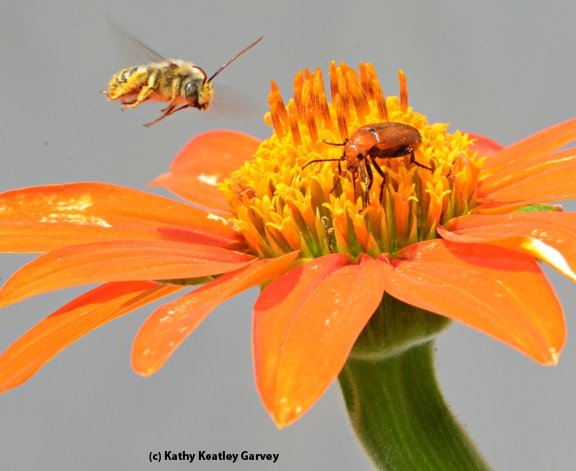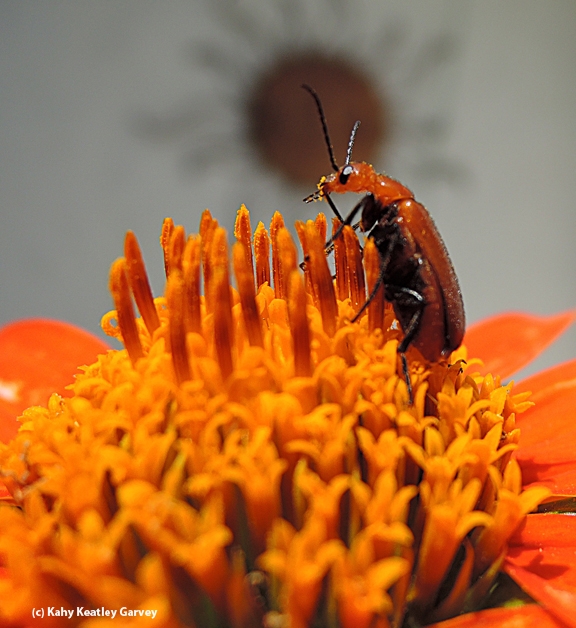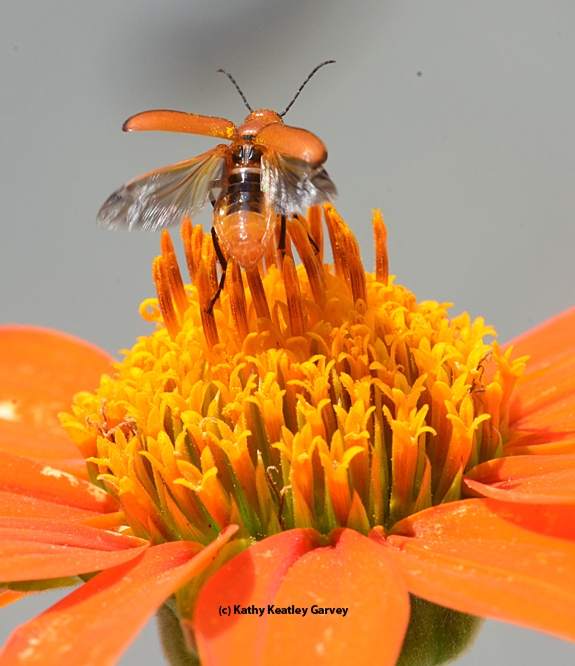So, what's a meloid beetle to do?
Here you are, a meloid beetle foraging on a Mexican sunflower (Tithonia) and these long-horned digger bees keep dive-bombing you and pestering you.
Then a Gulf Fritilllary butterfly (Agraulis vanillae) decides it wants a share of your flower.
So, it's take to take flight!
Blister beetles (family Meloidae) are known throughout the insect world for their defensive secretion of a blistering agent, cantharidin, according to Wikipedia. "About 7,500 species are known worldwide. Many are conspicuous and some are aposematically colored, announcing their toxicity to would-be predators."
Don't touch a blister beetle because that poisonous chemical can blister your skin.
Did you know that cantharidin is the principal irritant in Spanish fly, a folk medicine prepared from dried beetles in the Meloidae family? Wikipedia tells us so.
The UC Statewide Integrated Pest Management Program (UC IPM) offers information about blister beetles in a UC Pest Management Guideline on its website. "Blister beetles are narrow and elongate and the covering over the wings is soft and flexible. They may be solid colored (black or gray) or striped (usually orange or yellow and black) and are among the largest beetles likely to be found in a sweep net sample in alfalfa."
UC IPM points out that cantharidin is toxic to livestock. "Cantharidin is contained in the hemolymph (blood) of the beetles and may contaminate forage directly when beetles killed during harvest are incorporated into baled hay or indirectly by transfer of the hemolymph from crushed beetles onto forage. As the name implies, handling these insects may result in blisters, similar to a burn, on the hands or fingers. Blister beetles have been a serious problem in alfalfa in the northern United States, the Midwest, and the south for many years, but until recently have not been a problem in California."
Blister beetles have been linked to the death of several dairy cows in the southern Owens Valley, according to UC IPM. "At this point, it is not known if blister beetles are widespread or confined to the Owens Valley. Likewise, it is not known if the problem is likely to spread and hence become a common occurrence in California alfalfa. In the meantime, growers and PCAs (Pest Control Advisors) are advised to be on the lookout for blister beetles and to contact their farm advisor for advice if these insects are found."
Attached Images:

A male long-horned digger bee targets a pest, a meloid beetle. (Photo by Kathy Keatley Garvey)

A Gulf Fritillary butterfly shares a Mexican sunflower with a meloid beetle. (Photo by Kathy Keatley Garvey)

Close-up of a meloid beetle. (Photo by Kathy Keatley Garvey)

A meloid beetle about to take flight. (Photo by Kathy Keaetley Garvey)